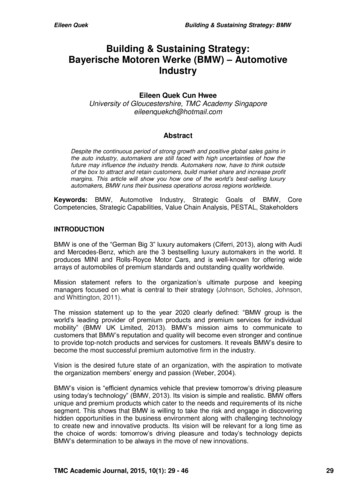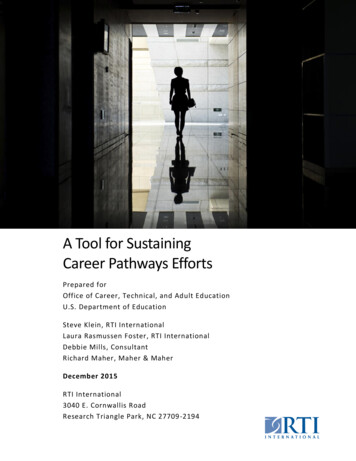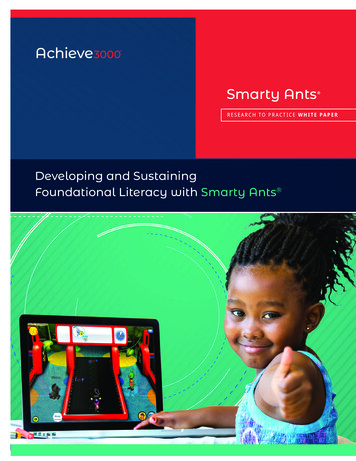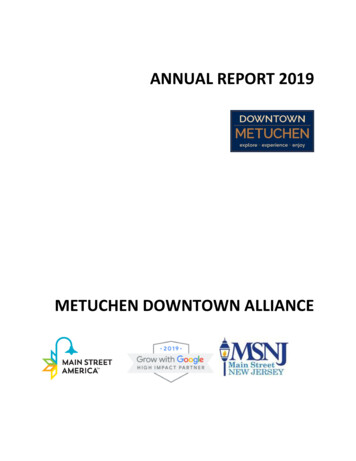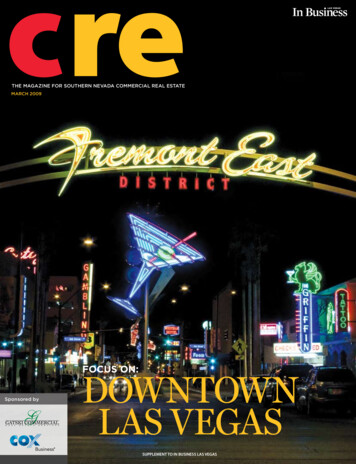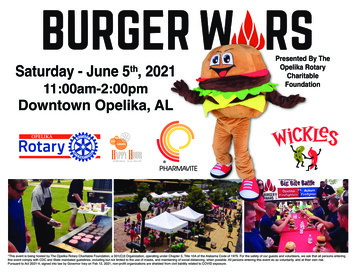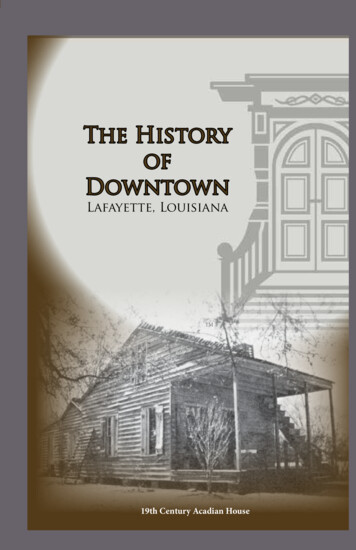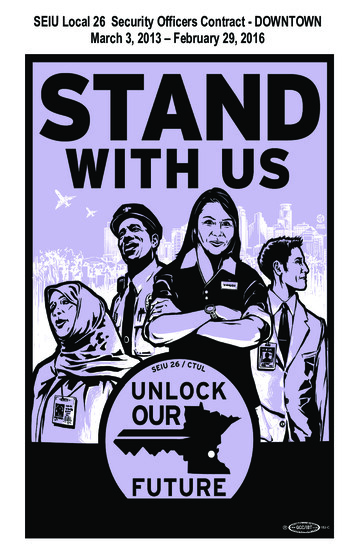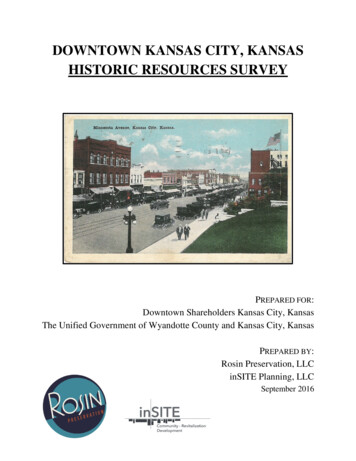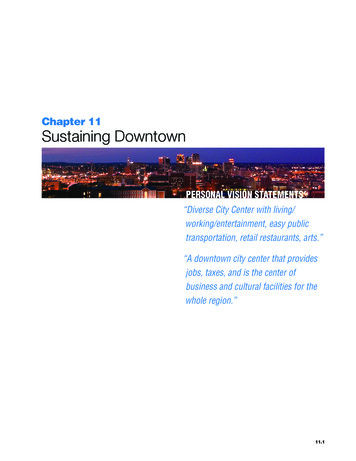
Transcription
Chapter 11Sustaining DowntownPERSONAL VISION STATEMENTS“Diverse City Center with living/working/entertainment, easy publictransportation, retail restaurants, arts.”“A downtown city center that providesjobs, taxes, and is the center ofbusiness and cultural facilities for thewhole region.”11.1
CITY OF BIRMINGHAM COMPREHENSIVE PLANPART IV CHAPTER 11 SUSTAINING DOWNTOWNGOALSPOLICIES FOR DECISION MAKERSDowntown is a thriving, mixed use centerof business, employment, institutions,and government. Build on downtown’s economic strengths as a center of health care, highereducation, finance, and professional and technical services.Downtown is also a neighborhoodthat people in the city and the regionexperience as a safe, fun, and excitingplace to live. Continue to strengthen downtown as a lively residential neighborhood.Downtown has a diverse andcontemporary mix of cultural, artsand entertainment venues that makeBirmingham a center of urban southernculture and lifestyle. Continue to strengthen downtown as the region’s center of culture, the arts, andentertainment.Downtown is made up of connected andmutually reinforcing districts. Continue to strengthen the pedestrian-friendly character of downtown. Support a residential marketing plan to attract, young professionals, downtownemployees, and new hires with targeted messages. Ensure strengthened connections for transit, pedestrians, bicyclists, and motoristbetween north and south, and linking downtown and adjacent districts. Advocate for state support for the rerouting of I-20/I-59 north of the BJCC area. Support a two-way street system for downtown. Support new zoning for downtown districts to streamline approvals for desireddevelopment.Downtown has a strong leadershiporganization active in planning,promotion, recruitment, development,and public realm improvements. Support a consistent financing plan for REV Birmingham (REV). Continue to work on implementation of the 2004 Center City Master Plan, withupdating and adjustments as appropriate. Review downtown neighborhood organization boundaries in light of the growingnumber of downtown residents.11.2
CITY OF BIRMINGHAM COMPREHENSIVE PLANPART IV CHAPTER 11 SUSTAINING DOWNTOWNfindingschallengesDowntown is a key employment center within the city,with approximately one-third of total city employment,and UAB is the largest single downtown employer by alarge margin.Continuing need to change perceptions of public safety.During the past 10 years, downtown industries experiencing the greatest growth were health care, highereducation, real estate rental and leasing, and “otherservices” (primarily religious, grantmaking, civic, andprofessional organizations).Attracting new uses to vacant and derelict buildings andvacant lots.Industries experiencing the largest decline were utilities,manufacturing, information, and wholesale trade.Expanding and diversifying housing options in a difficulteconomic climate.Compared to the rest of the Birmingham MSA, downtown has particularly high concentrations of employment in health care, higher education, government,information, professional, technical and scientificservices, utilities, and finance and insurance.Creating more amenities needed to create a 24-hourcommunity.REV Birmingham has undertaken a number of initiatives to strengthen downtown, including marketing andbusiness recruitment, small business financing, districtplanning, and a business retention program.Filling vacant ground floor with active uses to linkactivity areas.Retaining “graduates” of the Innovation Depot indowntown.Improving transportation choice, especial transitservice, in downtown to serve residents, commutersand visitors.Enhancing all types of connections between activity andreinvestment areas.The City Action Partnership, a nonprofit organizationfunded by downtown property owners, works in partnership with government, businesses, residents and theBirmingham Police Department to improve safety andthe perception of safety downtown.Downtown had an estimated 8,900 residents in 2010,an increase of 31 percent over 2000.The housing stock is predominantly rental.Residential occupancy rates are very high—99 percentfor rental units and 93 percent for owner-occupiedunits—indicating strong demand (early 2012).Downtown’s collection of historic buildings is unique tothe region and the state.Investment and activity downtown is fragmented, withnumerous small revitalization areas, tending to give theimpression of less activity than is the case.The 2004 City Center Master Plan has been partiallyimplemented.11.3
CITY OF BIRMINGHAM COMPREHENSIVE PLANPART IV CHAPTER 11 SUSTAINING DOWNTOWNA. W hat theCommunity Said Downtown districts still seem disconnected. Not enough attractions to get enough people out on thestreet. “Two downtowns:” west and east of 18th Street; daytimeand night time. Connect downtown activity centers with transit, especially the Birmingham-Jefferson Convention Center(BJCC) entertainment area and Five Points South, andconnect downtown to the rest of the city and regionwith transit. Pursue alternatives to the I-20/59 elevated highway toconnect the BJCC area with the rest of downtown. Implement the two-way street system recommended inthe 2004 City Center Master Plan and confirmed by a2010 feasibility study. Brand downtown districts and improve wayfinding.WHAT MAKES A DOWNTOWN SUCCESSFUL? Great places to live, work and play.A mixture of uses.Walkability, with lively and safe streets.Multiple activity generators within walking distance of oneanother.Entertainment as a driving market segment.Strong residential neighborhoods downtown and inadjacent neighborhoods.Safety and security.Broad public/private investment in downtown’s future.Citizen pride in downtown. Provide incentives for businesses to locate downtown. Attract more retail businesses, particularly grocery stores. Increase cultural attractions and other evening activities. Enhance lighting and other security measures. Provide affordable space for business-startups and retainstart-ups when they expand. Plan and promote space for Innovation Depot “graduates” in downtown. Enhance the pedestrian friendly character of downtown, Streamline the development process while protectingespecially to provide safe, well-lit, and appealing pedesplanning and design principles.trian routes between entertainment and activity centers. Continue supporting housing development and promotecondominium development. Provide incentives for property renovation, mixed usedevelopment, and historic preservation.HOW IS “DOWNTOWN” DEFINED?For the purposes of this chapter, downtown Birminghamencompasses the area between 11th Avenue North,from the entertainment district under constructionin 2012 surrounding the Birmingham-JeffersonConvention Center at the north to Highland Avenue tothe south, including the Five Points South entertainmentdistrict. The east and west boundaries are Red MountainExpressway and I-65 respectively, with the SlossFurnaces Historic Site and the Lakeview neighborhoodadjacent to the southeast quadrant functioning in someways as extensions of downtown.11.4B. RecommendationsDowntown Birmingham is the economic, employment,civic, cultural, entertainment and historic heart of theentire metropolitan region. Some 80,000 people cometo work in downtown Birmingham every day and anestimated 8,900 residents called downtown home in 2010.DOWNTOWN MANAGEMENTREV Birmingham (REV) is a public-private partnership thathas been leading downtown development since 1957under the nameOperation NewBirmingham. REV isdowntown’s urbanplanner; information
CITY OF BIRMINGHAM COMPREHENSIVE PLANPART IV CHAPTER 11 SUSTAINING DOWNTOWNclearinghouse; packager of financial incentives and loans;and promoter. REV is funded by contributions frombusiness and government. In 2012, ONB and BirminghamMain Streets merged, giving the combined organizationa broader mission to include commercial revitalizationoutside downtown and the new name.City Action Partnership (CAP) is funded by a property taxassessment on 96 blocks of downtown to provide securityand cleanliness. Since it began operation in 1996, crime hasdropped 62%.REAL ESTATE MARKET CONDITIONSNonresidential space. Downtown (including Lakeview) hasapproximately 5 million square feet of office space. Theoffice occupancy rate as of the third quarter of 2012 was84% with an average gross rental rate of about 21 persquare foot for Class A buildings.1 Occupancy will increasedue to recent rental of space at the Regions Plaza building.Industrial and retail real estate data is not broken down atthe level of downtown.Knowledgeable observers report that one of the majorissues downtown is that many vacant buildings are notactively marketed, require extensive renovation, or haveunrealistic rents for their condition.Residential space. According to a survey by REV ofdowntown residential developments, demand forresidential space in 2011 was very strong, with 99% ofrentals leased and 93% of condos sold. Unit types mostin demand are small efficiency or one-bedroom units atmodest rents ( 700–900 per month), but they are also themost difficult to produce from a financial point of view.This indicates that households most interested in livingdowntown are typically young singles or couples withmodest incomes. UAB employees and students likely are aprominent element of this demand.THE TWELVE-STEP PROGRAM FOR DOWNTOWNREVITALIZATIONIn 2005, real estate developer and researcher ChrisLeinberger identified twelve steps to revitalize downtowns.2In Birmingham, many of these steps are completed orongoing, but there are some areas that still need work. It isimportant to note that creating a critical mass of downtownresidents is the essential ingredient and lays the foundationfor a self-sustaining downtown, which typically takes 20years to attain.STEP 1 Capture the Vision and STEP 2 Develop a StrategicPlan. Birmingham’s City Center Plan of 2004 fulfilled bothof these steps and is still useful, though with modifications,eight years later as this comprehensive plan is beingprepared. The City Center Master Plan identified fiveprinciples for revitalization: Build on strengths.Enhance connections and gateways.Develop “green streets,” making key corridors tree-lined.Reorganize the highway and street network.Strengthen and expand residential neighborhoods.STEP 3 Forge a Healthy Private/Public Partnership.REV Birmingham has been Birmingham’s downtownleadership organization and partnership for fifty years.Leinberger’s focus on what makes a “healthy” partnershipis on ensuring that the private sector leads while the publicsector supports. Another aspect of a healthy partnership isensuring a consistent and adequate funding source for theorganization to be effective. This has been problematic forREV Birmingham in recent years.STEP 4 Make the Right Thing Easy. Development regulationsshould promote mixed-use development and restore thehistoric right-of-way fabric downtown. Leinberger notes:“over the years, streets as freeways (one way streets meantto encourage automobile speed), streets as regionalmalls (streets closed off to traffic), and streets as onramps became ubiquitous fads. Restoring the originalstreet right-of-way fabric, including tight corner turningradiuses, will bring back one of downtowns major assets1Cushman & Wakefield, MarketBeat Office Snapshot: Birmingham, AL, Q3 2012.This is for their “CBD” market area, which includes all of downtown Birminghamplus Lakeview.2“Turning Around Downtown: Twelve Steps to Downtown Revitalization,” (2005)Brookings Institution. www.brookings.edu.11.5
CITY OF BIRMINGHAM COMPREHENSIVE PLANPART IV CHAPTER 11 SUSTAINING DOWNTOWNand help re-create the walkable urbanism these citieswere designed for.”Although a study confirmed that return to two-way streetsis feasible, it has not been implemented.Birmingham has adopted the 2009 International BuildingCode, which makes adaptive reuse of older buildings easier.The development permitting process, however, involvesmany steps and could be streamlined somewhat with moretransparent and explicit zoning and design standards.STEP 6 Create a Catalytic Development Company. A catalyticdeveloper is a redevelopment organization that undertakesthe initial projects that other developers see as too riskyor for which they have difficulty getting financing. Thisrole is often played by a redevelopment authority, butthere are also examples of private corporations organizedto be “double bottom line” investors with “patient capital.”Typically, these organizations assemble land, prepare landfor development (through environmental assessmentand cleanup, for example), provide gap financing, andsometimes develop buildings from start to finish.STEP 5 Establish Business Improvement Districts andNew development in downtown Birmingham hasOther Non-Profits. Consistent funding for downtownalready demonstrated success, so a catalytic developmentorganizations and revitalization nonprofits is essential,corporation is not needed to just show that projects can beso that they do not have to rely on basic funding forsuccessful. However, an entity is lacking that can assemblefoundation grants or variable government subsidies. Thisand prepare sites, provide financing for key infill sites, andis often accomplished through Business Improvementassist with particularly costly rehabilitation projects or withDistricts (BIDs) or similar organizations. BIDs typicallyprojects in emerging districts.combine a leadership role in managing implementationof the downtown strategy with an operational role to keepThe Community Foundation has created the Communitydowntown safe, clean, active, and with a good image—allCatalyst Funds to invest in the city center. The Catalystof these roles being funded through an assessment onFunds will seek opportunities to invest in Birmingham’s Citydowntown property that is collected with property tax. InCenter
Birmingham a center of urban southern culture and lifestyle. Continue to strengthen downtown as the region’s center of culture, the arts, and entertainment. Downtown is made up of connected and mutually reinforcing districts. Continue to strengthen the pedestrian-friendly character of downtown. Ensure strengthened connections for transit, pedestrians, bicyclists, and motorist .
